Header Image from National Park Service.gov Mammoth Cave National Park, Kentucky.
Kentucky was admitted as the 15th state on June 1,1792.
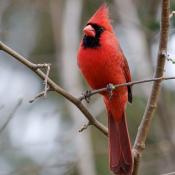
Bird: Northern Cardinal
Unlike many other songbirds in North America, both the male and female cardinals can sing. Usually, only a male songbird is capable of singing. When a female cardinal sings from the nest, it usually means she’s telling the male she needs more food. Cardinals mate for life. A group of cardinals has many collective nouns, including a “college”, “conclave”, “deck”, “radiance”, and “Vatican” of cardinals.
The cardinal is the mascot of prominent sports teams and schools, including the St. Louis Cardinals (baseball) and Arizona Cardinals (football); it is the state bird of seven states, more than any other bird: Illinois, Indiana, Kentucky, North Carolina, Ohio, Virginia, West Virginia
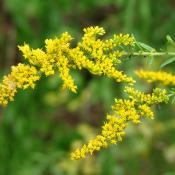 Flower: Goldenrod
Flower: Goldenrod
Goldenrods are considered a sign of good luck or good fortune. As a natural remedy, goldenrod has been used to reduce pain and swelling (inflammation), as a diuretic to increase urine flow, and to stop muscle spasms.
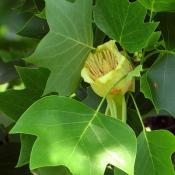 Tree: Tulip Tree
Tree: Tulip Tree
The tulip poplar is not actually a poplar tree, but a member of the magnolia family. The tulip poplar leaf has a unique, distinct shape (it appears in the border of the Indiana state seal), and produces huge, bell-shaped greenish-yellow with orange flowers in the spring.
The tulip poplar is the tallest eastern hardwood tree and produces large tulip-like flowers in the spring which have a delightful fragrance of nectar that even attracts birds (including ruby-throated hummingbirds).
The wood of the North American species (called poplar or tulipwood) is fine grained and stable. It is easy to work and commonly used for cabinet and furniture framing, i.e. internal structural members and sub-surfaces for veneering. Additionally, much inexpensive furniture, described for sales purposes simply as “hardwood”, is in fact primarily stained poplar. In the literature of American furniture manufacturers from the first half of the 20th century, it is often referred to as “gum wood”. The wood is only moderately rot-resistant and is not commonly used in shipbuilding, but has found some recent use in light-craft construction.
The name canoewood probably refers to the tree’s use for construction of dugout canoes by eastern Native Americans, for which its fine grain and large trunk size is eminently suited. State tree of Indiana, Tennessee, and Kentucky
State Quarter
From theus50.com
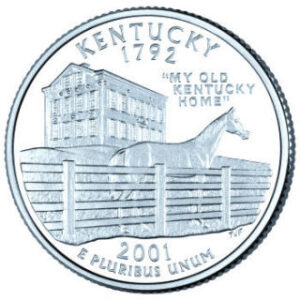
The Kentucky quarter shows the stately mansion, Federal Hill, with an inscription that reads, “My Old Kentucky Home”. A thoroughbred racehorse is positioned behind a fence in the foreground of the quarter.
Kentucky was the first state on the western frontier to join the Union and is one of four states to call itself a “commonwealth.” Kentucky is home of the longest running annual horse race in the country, the Kentucky Derby. The famous Kentucky Bluegrass country is also grazing ground for some of the world’s finest racehorses. Also featured on the new quarter is another prominent symbol of Kentucky, Federal Hill, which has become known as “My Old Kentucky Home.” The design shows a side view of the famous Bardstown home where Stephen Foster wrote the state song, “My Old Kentucky Home”.
Name: From an Iroquoian word “Ken-tah-ten” meaning “land of tomorrow”
Capital: Frankfort
Nickname: Bluegrass State
Motto: United we stand, divided we fall
Kentucky History
When the Europeans arrived in the 1600s, there were no major Native American tribes that permanently lived in Kentucky. The land of Kentucky was mostly used as hunting grounds for tribes such as the Cherokee, the Delaware, and the Shawnee.
Although British settlers were looking for new land to the west, few had ventured into Kentucky because it was so difficult to cross the Appalachian Mountains. In 1750, explorer Dr. Thomas Walker discovered a pass through the mountains. He called it the Cumberland Gap.
In 1763, at the end of the French and Indian War, the British promised the Indians that they would not settle beyond the Appalachian Mountains. However, the colonists didn’t agree with this promise and started to settle Kentucky anyway. In 1774 Harrodstown (now Harrodsburg) was established as the first permanent settlement in the Kentucky region. It was named after James Harrod who led a team of area surveyors.
The Shawnee were not happy that the Europeans were building homes on their hunting grounds. They attacked the settlers and in 1774, the Governor of Virginia, Lord Dunmore, declared war on the Shawnee. The Shawnee were defeated at the Battle of Point Pleasant. As a result, the Shawnee and the settlers agreed to use the Ohio River as a border between the British colonists and the Shawnee.
In 1775, Daniel Boone led a number of settlers into Kentucky to establish the town of Boonesborough. He also widened and improved the trail across the Cumberland Gap so that wagons could travel through. This trail became known as the Wilderness Road.
After the Revolutionary War, Kentucky became a part of the state of Virginia but the people of Kentucky wanted to make their own government. They applied for statehood and on June 1, 1792 Kentucky became the 15th state.
During the Civil War, Kentucky was a border state and also a slave state. There were people within the state who sided with the North and others that sided with the South. At the start of the war, Kentucky refused to take sides and remained neutral. However, when the Confederate Army invaded, Kentucky declared its loyalty for the Union. Major battles that occurred in Kentucky include the Battle of Mill Springs and the Battle of Perryville.
It is interesting to note that both the leader of the Union, Abraham Lincoln, and the leader of the Confederacy, Jefferson Davis, were both born in Kentucky.
Kentucky Facts and Trivia
Mammoth Cave is the world’s longest cave and was first promoted in 1816, making it the second oldest tourist attraction in the United States. Niagara Falls, New York is first.
The Kentucky Derby is the oldest continuously held horse race in the country. Started in 1875, it is held at Churchill Downs in Louisville on the first Saturday in May.
Cheeseburgers were first served in 1934 at Kaolin’s restaurant in Louisville.
Christian County is wet while Bourbon County is dry. Barren County has the most fertile land in the state.
More than 100 native Kentuckians have been elected governors of other states.
In 1888, “Honest Dick” Tate the state treasurer embezzled $247,000 and fled the state.
The song “Happy Birthday to You” was the creation of two Louisville sisters in 1893.
Teacher Mary S. Wilson held the first observance of Mother’s Day in Henderson in 1887. It was made a national holiday in 1916.
The great Man o’ War won all of his horse races except one which he lost to a horse named Upset.
The first town in the United States to be named for the first president was Washington. It was named in 1780.
Bluegrass is not really blue–its green–but in the spring bluegrass produces bluish purple buds that when seen in large fields give a blue cast to the grass. Today Kentucky is known as the Bluegrass State.
The only monument south of the Ohio River dedicated to Union Soldiers who died in the Civil War is located in Vanceburg.
The public saw an electric light for the first time in Louisville. Thomas Edison introduced his incandescent light bulb to crowds at the Southern Exposition in 1883.
The radio was invented by a Kentuckian named Nathan B. Stubblefield of Murray in 1892. It was three years before Marconi made his claim to the invention.
The first enamel bathtub was made in Louisville in 1856.
In the War of 1812 more than half of all Americans killed in action were Kentuckians.
More than $6 billion worth of gold is held in the underground vaults of Fort Knox. This is the largest amount of gold stored anywhere in the world.
Pike County the world’s largest producer of coal is famous for the Hatfield-McCoy feud, an Appalachian vendetta that lasted from the Civil War to the 1890s.
Bluegrass music is a popular and respected form of American roots music, or traditional U.S. folk music. Bluegrass gets its name from Bill Monroe’s band The Blue Grass Boys. The genre incorporates elements of British traditional songs, Appalachian folk music, and African-American music traditions like blues and jazz. Bluegrass is characterized by its use of acoustic string instruments—especially the fiddle and banjo—and its multi-layered vocals, which give it a distinctive sound. Like jazz, bluegrass can be highly improvisational.
In southern Kentucky, earthworms are called redworms, a burlap bag is known as a tow sack or the Southern grass sack, and green beans are called snap beans. In Kentucky English, a young man may carry, not escort, his girlfriend to a party.
In Presidential elections Kentucky has been strongly Republican since 1960 with the exception of three Democratic candidates, all from Southern states: Lyndon B. Johnson (Texas) in 1964, Jimmy Carter (Georgia) in 1976, and Bill Clinton (Arkansas) in 1992 and 1996. In 2016 Donald Trump carried Kentucky with 62.5% of the vote.
Strange Laws
No female in a bikini shall appear on any Kentucky highway unless she is accompanied by 2 officers, or armed with a club. This does not apply to females under 60 pounds or over 200 pounds, nor does it apply to female horses.
No one shall dye blue and sell baby ducks, chicks or rabbits, unless doing so in groups of 6 or more. Otherwise they will face a fine of $500.
Each citizen of Kentucky is required to shower once each year.
Women are not allowed to purchase a new hat without the authorization of their husband
Throwing flowers at a public speaker could result in up to one year in prison.
People:
- Muhammad Ali, boxer
- Alben W. Barkley, the oldest United States Vice President when he assumed office in 1949. He was 71 years old.
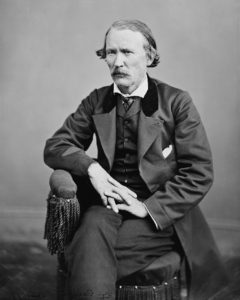 Kit Carson, scout
Kit Carson, scout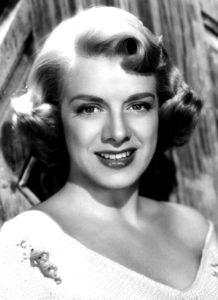 Rosemary Clooney, singer
Rosemary Clooney, singer- Jefferson Davis, president of the Confederacy
- Irene Dunne, actress
- Crystal Gayle, singer
- Casey Jones, locomotive engineer
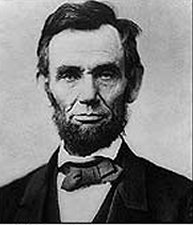 Abraham Lincoln, U.S. president
Abraham Lincoln, U.S. president- Loretta Lynn, singer
- Carry Amelia Nation, temperance leader
- Patricia Neal, actress
- Diane Sawyer, broadcast journalist
- Frederick Vinson, the only Chief Justice of the United States Supreme Court known to be born in jail.
Credits:
See Bubbleland, KY
See 50states.com
See ducksters.com
See Wikipedia
See Info Please
